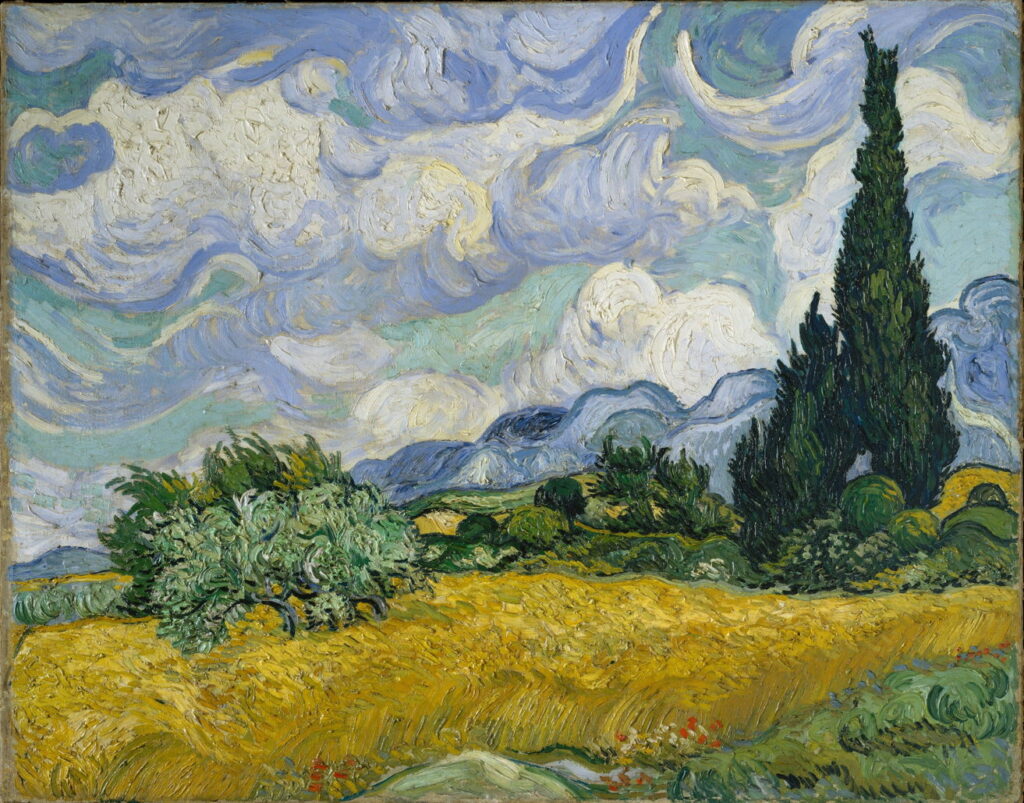A to Z of Landscapes: Cloudscapes

In landscape painting, the letter C is for clouds and the cloudscapes they form. It was perhaps the late landscape paintings of Peter Paul Rubens that marked the start of their development.
Peter Paul Rubens (1577–1640), An Autumn Landscape with a View of Het Steen in the Early Morning (c 1636), oil on oak, 131.2 x 229.2 cm, The National Gallery (Sir George Beaumont Gift, 1823/8), London. Courtesy of and © The National Gallery, London.
Rubens’ An Autumn Landscape with a View of Het Steen in the Early Morning, painted during his retirement in about 1636, is one of the larger of these, capturing the light as the sun is rising off to the right. He was followed by the great landscape artists of the Dutch Golden Age.
Salomon van Ruysdael (c 1600/1603–1670), View of Alkmaar from the Sea (c 1650), oil on panel, 36 x 33 cm, Private collection. Wikimedia Commons.
Salomon van Ruysdael filled his panels and canvases with the sky, as in his View of Alkmaar from the Sea from about 1650. Clouds had now become subjects in their own right, and the differences in their form and texture worth getting right.
Caspar David Friedrich (1774–1840), Moonrise over the Sea (c 1821), oil on canvas, 135 x 170 cm, Hermitage Museum Государственный Эрмитаж, Saint Petersburg, Russia. Wikimedia Commons.
In the 1820s, Caspar David Friedrich painted several coastal nocturnes with enigmatic figures, such as this Moonrise over the Sea from about 1821.
Caspar David Friedrich (1774–1840), Seashore by Moonlight (1835–36), oil on canvas, 134 × 169.2 cm, Kunsthalle, Hamburg. Wikimedia Commons.
Seashore by Moonlight (1835–6), one of Friedrich’s last oil paintings, is much darker and full of foreboding. The clouds are deep indigo, in smooth folds and curves threatening rain.
John Constable (1776–1837), Weymouth Bay with a Storm Approaching (1818), oil on canvas, dimensions not known, Musée du Louvre, Paris. Wikimedia Commons.
After John Constable had honeymooned on the south coast of England in 1816, he returned to paint around several of its resorts, including Weymouth and Brighton. Weymouth Bay with a Storm Approaching (1818) was most probably painted out of season, judging by the few people on the beach, and shows a storm coming up from the south-west.
John Constable (1776–1837), Salisbury Cathedral from the Meadows (1831), oil on canvas, 151.8 × 189.9 cm, The Tate Gallery, London. Wikimedia Commons.
Constable’s lifelong obsession with skies didn’t work out as well in some of his later finished paintings. Salisbury Cathedral from the Meadows (1831), one of his series of the cathedral, was perhaps over-egged with its storm clouds, rainbow and bolt of lightning.
Joseph Mallord William Turner (1775–1851), Snow Storm: Hannibal and his Army Crossing the Alps (1812), oil on canvas, 146 x 237.5 cm, The Tate Gallery (Turner Bequest 1856), London. Photographic Rights © Tate 2018, CC-BY-NC-ND 3.0 (Unported), https://www.tate.org.uk/art/artworks/turner-snow-storm-hannibal-and-his-army-crossing-the-alps-n00490
Inspired by his own experience of crossing Alpine passes, JMW Turner’s sky in his radical Snow Storm: Hannibal and his Army Crossing the Alps from 1812 is among his most dramatic. He seems to have become so carried away by the towering indigo vortex of storm cloud that he almost forgot to show Hannibal’s famous elephants.
Joseph Mallord William Turner (1775–1851), Snow Storm, Steam Boat off a Harbour’s Mouth (1842), oil on canvas, 91.4 x 121.9 cm, The Tate Gallery (Accepted by the nation as part of the Turner Bequest 1856), London. Photographic Rights © Tate 2016, CC-BY-NC-ND 3.0 (Unported), http://www.tate.org.uk/art/artworks/turner-snow-storm-steam-boat-off-a-harbours-mouth-n00530
In Snow Storm, Steam Boat off a Harbour’s Mouth from 1842, Turner’s cloud forms continue to dissolve into vortices of colour and light, that have come to replace the more linear streamlines used by most other landscape painters.
Eugène Boudin (1824–1898), The Beach at Villerville (1864), oil on canvas, 45.7 × 76.3 cm, The National Gallery of Art, Washington, DC. Wikimedia Commons.
The pre-Impressionist Eugène Boudin developed the cloudscape further in his paintings of the beaches of the north French coast, here his Beach at Villerville from 1864.
Bruno Liljefors (1860–1939), Hunting Geese (1896), oil on canvas, 61 × 137 cm, location not known. Wikimedia Commons.
Some of the great Swedish natural history painter Bruno Liljefors’ finest works are almost pure cloudscapes, such as his Hunting Geese from 1896, with its superb mackerel sky.
Vincent van Gogh (1853–1890), Wheat Field with Cypresses (1889), oil on canvas, 73.2 × 93.4 cm, Metropolitan Museum of Art, New York, NY. Wikimedia Commons.
In the summer of 1889, Vincent van Gogh’s several variations of Wheat Field with Cypresses feature low horizons below skies of swirling forms that start to integrate with the hills and vegetation.
Ferdinand Hodler (1853–1918), Rhythmic Landscape on Lake Geneva (1908), oil on canvas, 67 x 91 cm, Private collection. Wikimedia Commons.
In 1908 when Ferdinand Hodler was in pursuit of Parallelist ideals, he painted this Rhythmic Landscape on Lake Geneva. Most of his symmetry and rhythm is obvious; what may not be so apparent are the idiosyncratic reflections seen on the lake’s surface. The gaps in the train of cumulus clouds here become optically impossible dark blue pillars, responsible for much of the rhythm in the lower half of the painting.
The culmination came with Paul Nash’s Surrealist clouds that became what he saw in his imagination.
Paul Nash (1892–1946), Flight of the Magnolia (1944), oil on canvas, 51.1 x 76.2 cm, The Tate Gallery (Purchased with assistance from donors 1999), London. © The Tate Gallery and Photographic Rights © Tate (2016), CC-BY-NC-ND 3.0 (Unported), http://www.tate.org.uk/art/artworks/nash-flight-of-the-magnolia-t07552
In Flight of the Magnolia (1944), a magnolia flower unfurls into the sky high above a low coastal landscape. Those vast, soft petals are set against a background of equally huge leaves, and beyond them a field of cumulus clouds so typical of an English summer. Those below the flower have heaped up to generate a shower in the far distance.


